THE201A Trends and Issues in the Visitor Economy: Restaurant Report
VerifiedAdded on 2022/09/06
|6
|1445
|19
Report
AI Summary
This report analyzes the trends and issues within the visitor economy, specifically focusing on the restaurant industry. It examines the impact of globalization and cultural diversity on restaurant operations, using Indian Accent and Australian restaurants as comparative examples. The report explores how factors such as consumer lifestyle changes, cultural influences, and the adoption of new trends, including non-alcoholic beverages and innovative food preparations, affect restaurant strategies. It highlights the importance of adapting to cultural nuances and tourist preferences to enhance customer engagement and business success. The study also considers the implications of these trends for the broader hospitality industry, emphasizing the need for restaurants to understand and respond to evolving consumer demands and cultural sensitivities to remain competitive in the global market.
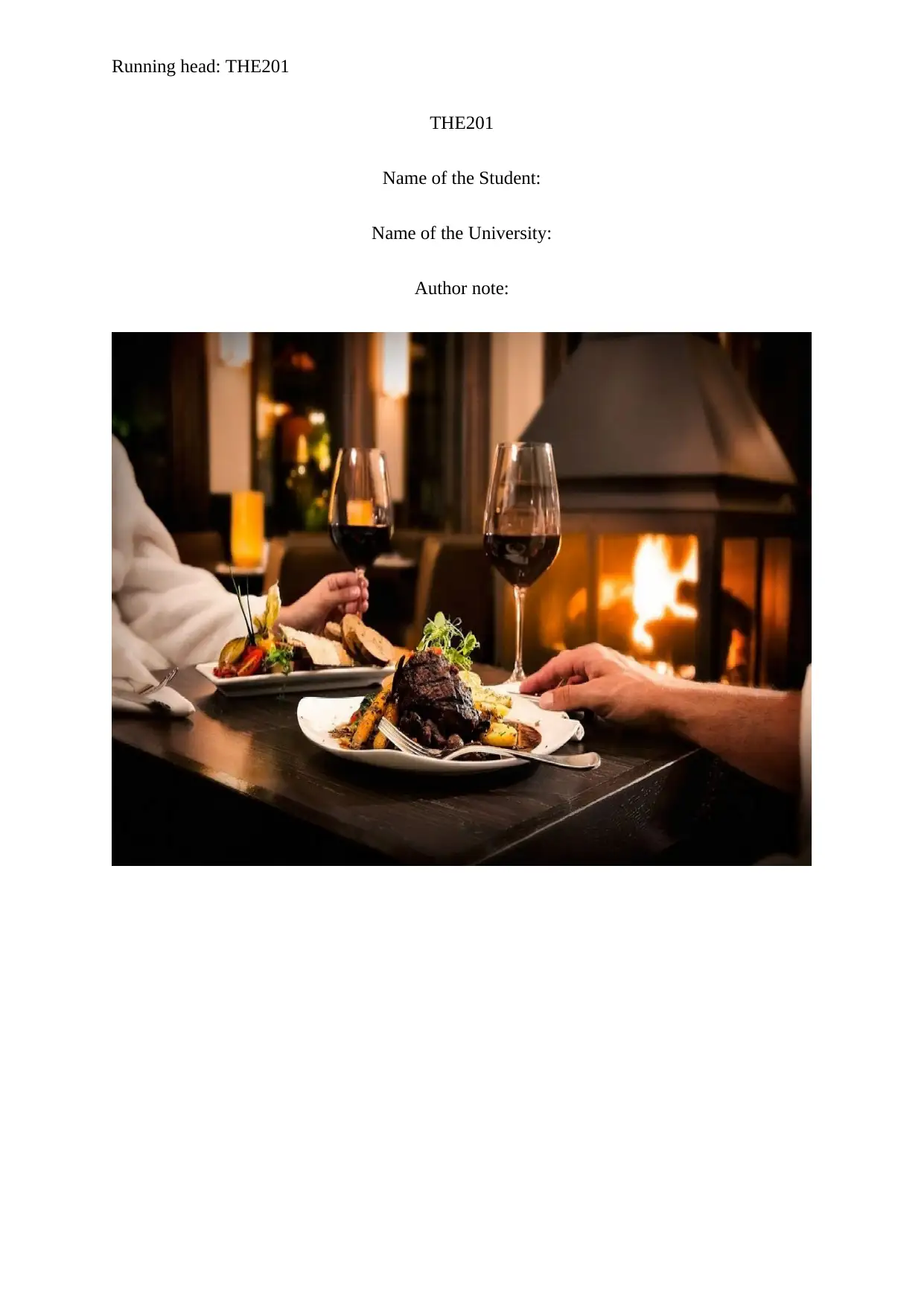
Running head: THE201
THE201
Name of the Student:
Name of the University:
Author note:
THE201
Name of the Student:
Name of the University:
Author note:
Paraphrase This Document
Need a fresh take? Get an instant paraphrase of this document with our AI Paraphraser
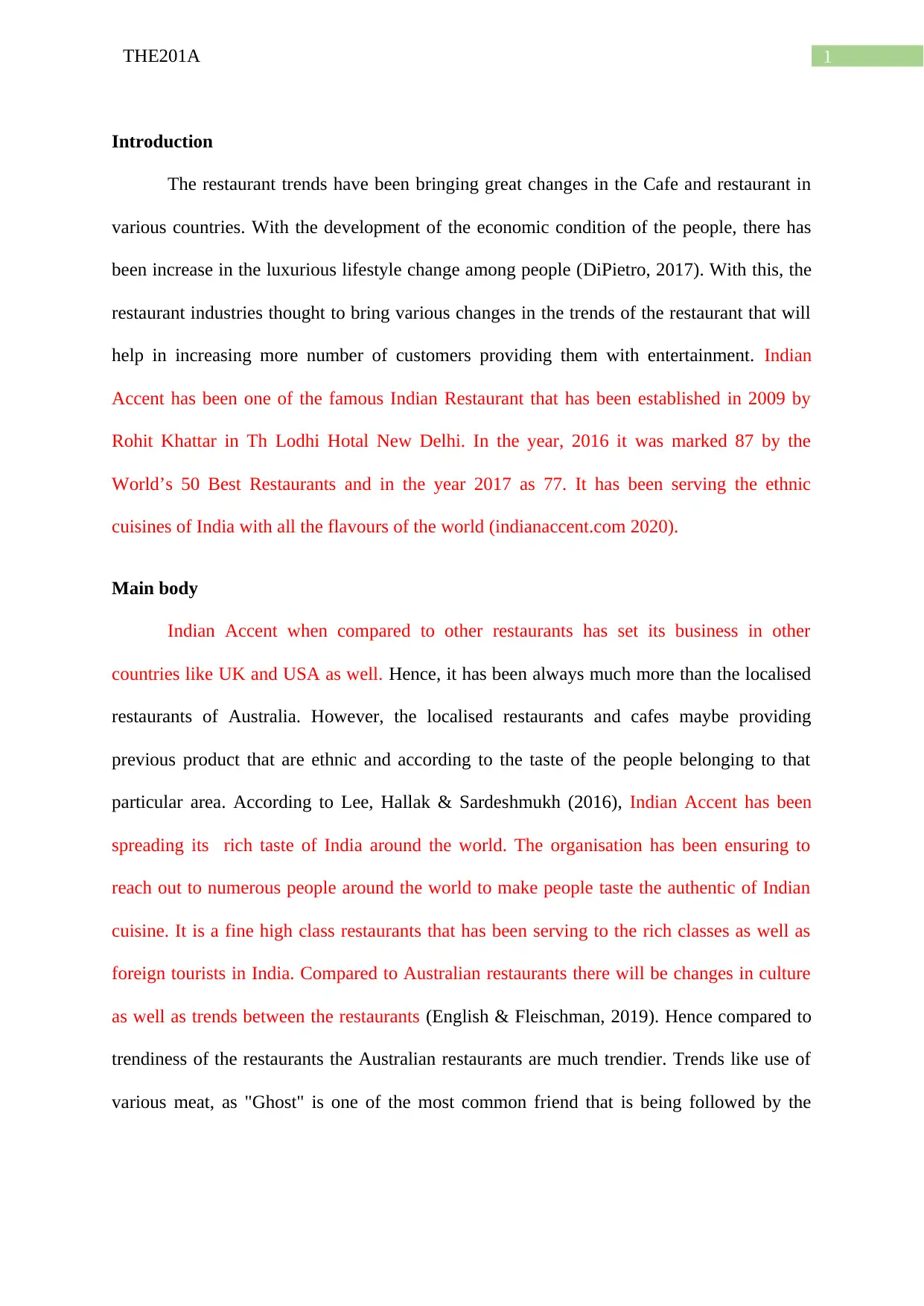
1THE201A
Introduction
The restaurant trends have been bringing great changes in the Cafe and restaurant in
various countries. With the development of the economic condition of the people, there has
been increase in the luxurious lifestyle change among people (DiPietro, 2017). With this, the
restaurant industries thought to bring various changes in the trends of the restaurant that will
help in increasing more number of customers providing them with entertainment. Indian
Accent has been one of the famous Indian Restaurant that has been established in 2009 by
Rohit Khattar in Th Lodhi Hotal New Delhi. In the year, 2016 it was marked 87 by the
World’s 50 Best Restaurants and in the year 2017 as 77. It has been serving the ethnic
cuisines of India with all the flavours of the world (indianaccent.com 2020).
Main body
Indian Accent when compared to other restaurants has set its business in other
countries like UK and USA as well. Hence, it has been always much more than the localised
restaurants of Australia. However, the localised restaurants and cafes maybe providing
previous product that are ethnic and according to the taste of the people belonging to that
particular area. According to Lee, Hallak & Sardeshmukh (2016), Indian Accent has been
spreading its rich taste of India around the world. The organisation has been ensuring to
reach out to numerous people around the world to make people taste the authentic of Indian
cuisine. It is a fine high class restaurants that has been serving to the rich classes as well as
foreign tourists in India. Compared to Australian restaurants there will be changes in culture
as well as trends between the restaurants (English & Fleischman, 2019). Hence compared to
trendiness of the restaurants the Australian restaurants are much trendier. Trends like use of
various meat, as "Ghost" is one of the most common friend that is being followed by the
Introduction
The restaurant trends have been bringing great changes in the Cafe and restaurant in
various countries. With the development of the economic condition of the people, there has
been increase in the luxurious lifestyle change among people (DiPietro, 2017). With this, the
restaurant industries thought to bring various changes in the trends of the restaurant that will
help in increasing more number of customers providing them with entertainment. Indian
Accent has been one of the famous Indian Restaurant that has been established in 2009 by
Rohit Khattar in Th Lodhi Hotal New Delhi. In the year, 2016 it was marked 87 by the
World’s 50 Best Restaurants and in the year 2017 as 77. It has been serving the ethnic
cuisines of India with all the flavours of the world (indianaccent.com 2020).
Main body
Indian Accent when compared to other restaurants has set its business in other
countries like UK and USA as well. Hence, it has been always much more than the localised
restaurants of Australia. However, the localised restaurants and cafes maybe providing
previous product that are ethnic and according to the taste of the people belonging to that
particular area. According to Lee, Hallak & Sardeshmukh (2016), Indian Accent has been
spreading its rich taste of India around the world. The organisation has been ensuring to
reach out to numerous people around the world to make people taste the authentic of Indian
cuisine. It is a fine high class restaurants that has been serving to the rich classes as well as
foreign tourists in India. Compared to Australian restaurants there will be changes in culture
as well as trends between the restaurants (English & Fleischman, 2019). Hence compared to
trendiness of the restaurants the Australian restaurants are much trendier. Trends like use of
various meat, as "Ghost" is one of the most common friend that is being followed by the
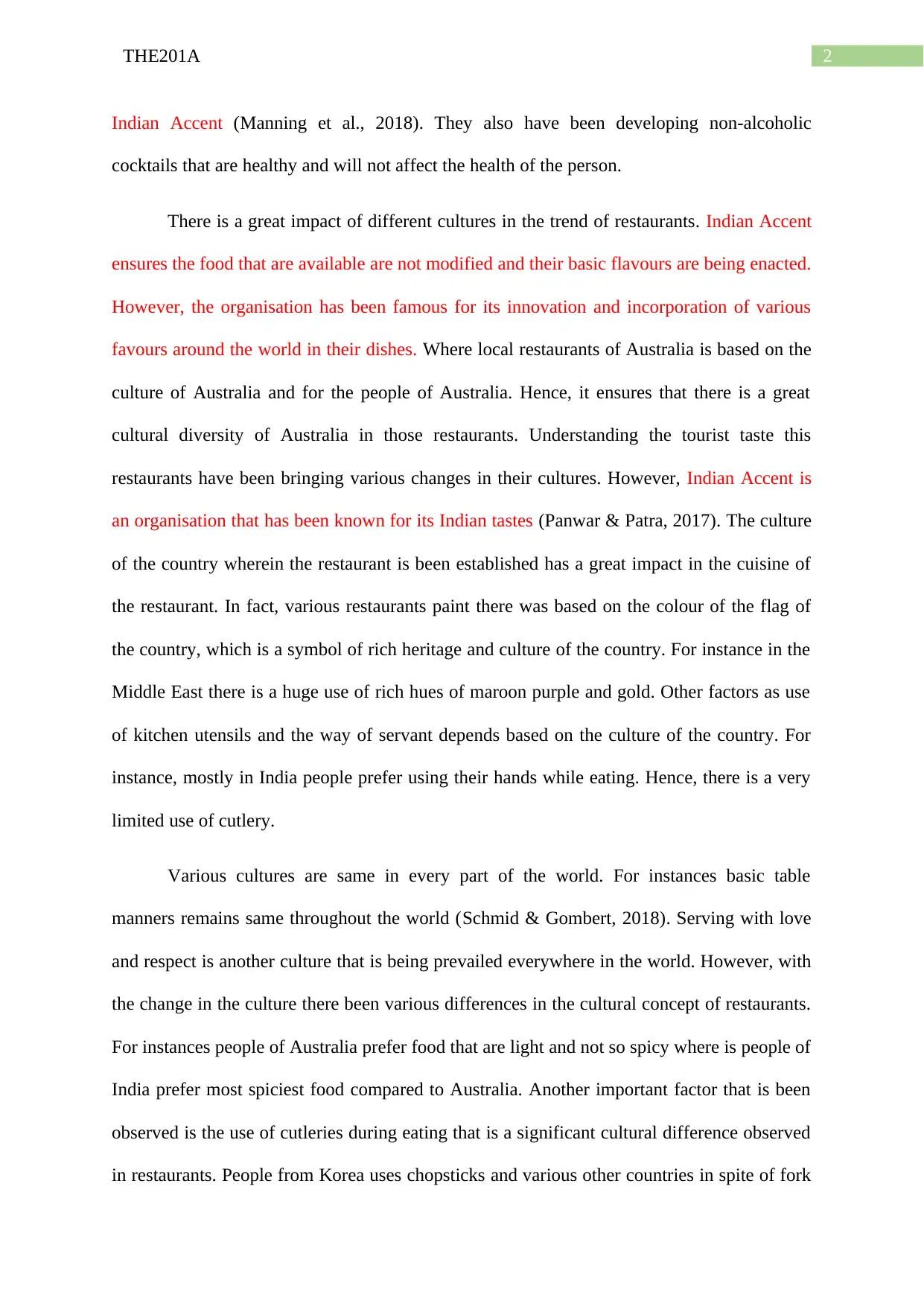
2THE201A
Indian Accent (Manning et al., 2018). They also have been developing non-alcoholic
cocktails that are healthy and will not affect the health of the person.
There is a great impact of different cultures in the trend of restaurants. Indian Accent
ensures the food that are available are not modified and their basic flavours are being enacted.
However, the organisation has been famous for its innovation and incorporation of various
favours around the world in their dishes. Where local restaurants of Australia is based on the
culture of Australia and for the people of Australia. Hence, it ensures that there is a great
cultural diversity of Australia in those restaurants. Understanding the tourist taste this
restaurants have been bringing various changes in their cultures. However, Indian Accent is
an organisation that has been known for its Indian tastes (Panwar & Patra, 2017). The culture
of the country wherein the restaurant is been established has a great impact in the cuisine of
the restaurant. In fact, various restaurants paint there was based on the colour of the flag of
the country, which is a symbol of rich heritage and culture of the country. For instance in the
Middle East there is a huge use of rich hues of maroon purple and gold. Other factors as use
of kitchen utensils and the way of servant depends based on the culture of the country. For
instance, mostly in India people prefer using their hands while eating. Hence, there is a very
limited use of cutlery.
Various cultures are same in every part of the world. For instances basic table
manners remains same throughout the world (Schmid & Gombert, 2018). Serving with love
and respect is another culture that is being prevailed everywhere in the world. However, with
the change in the culture there been various differences in the cultural concept of restaurants.
For instances people of Australia prefer food that are light and not so spicy where is people of
India prefer most spiciest food compared to Australia. Another important factor that is been
observed is the use of cutleries during eating that is a significant cultural difference observed
in restaurants. People from Korea uses chopsticks and various other countries in spite of fork
Indian Accent (Manning et al., 2018). They also have been developing non-alcoholic
cocktails that are healthy and will not affect the health of the person.
There is a great impact of different cultures in the trend of restaurants. Indian Accent
ensures the food that are available are not modified and their basic flavours are being enacted.
However, the organisation has been famous for its innovation and incorporation of various
favours around the world in their dishes. Where local restaurants of Australia is based on the
culture of Australia and for the people of Australia. Hence, it ensures that there is a great
cultural diversity of Australia in those restaurants. Understanding the tourist taste this
restaurants have been bringing various changes in their cultures. However, Indian Accent is
an organisation that has been known for its Indian tastes (Panwar & Patra, 2017). The culture
of the country wherein the restaurant is been established has a great impact in the cuisine of
the restaurant. In fact, various restaurants paint there was based on the colour of the flag of
the country, which is a symbol of rich heritage and culture of the country. For instance in the
Middle East there is a huge use of rich hues of maroon purple and gold. Other factors as use
of kitchen utensils and the way of servant depends based on the culture of the country. For
instance, mostly in India people prefer using their hands while eating. Hence, there is a very
limited use of cutlery.
Various cultures are same in every part of the world. For instances basic table
manners remains same throughout the world (Schmid & Gombert, 2018). Serving with love
and respect is another culture that is being prevailed everywhere in the world. However, with
the change in the culture there been various differences in the cultural concept of restaurants.
For instances people of Australia prefer food that are light and not so spicy where is people of
India prefer most spiciest food compared to Australia. Another important factor that is been
observed is the use of cutleries during eating that is a significant cultural difference observed
in restaurants. People from Korea uses chopsticks and various other countries in spite of fork
⊘ This is a preview!⊘
Do you want full access?
Subscribe today to unlock all pages.

Trusted by 1+ million students worldwide
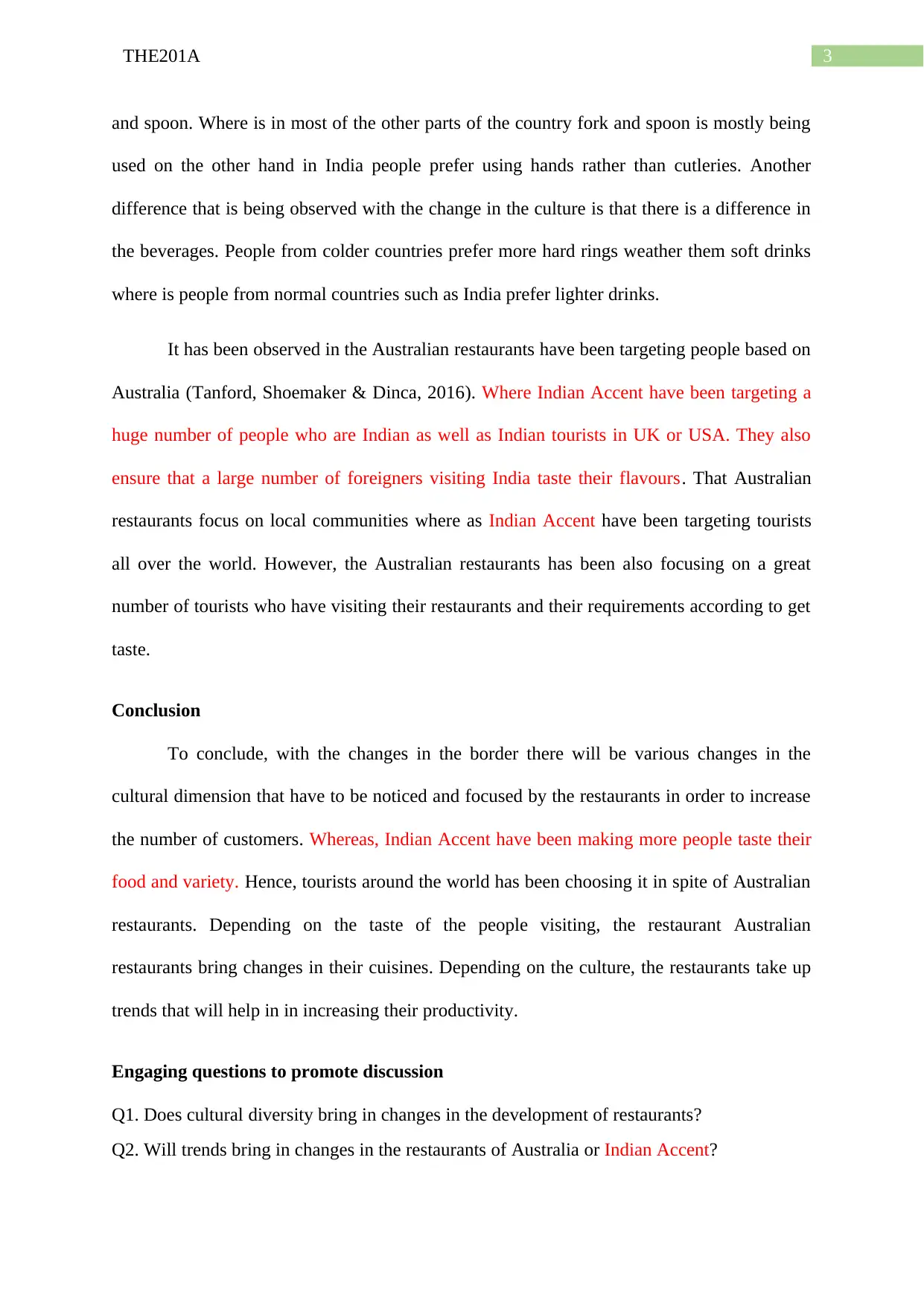
3THE201A
and spoon. Where is in most of the other parts of the country fork and spoon is mostly being
used on the other hand in India people prefer using hands rather than cutleries. Another
difference that is being observed with the change in the culture is that there is a difference in
the beverages. People from colder countries prefer more hard rings weather them soft drinks
where is people from normal countries such as India prefer lighter drinks.
It has been observed in the Australian restaurants have been targeting people based on
Australia (Tanford, Shoemaker & Dinca, 2016). Where Indian Accent have been targeting a
huge number of people who are Indian as well as Indian tourists in UK or USA. They also
ensure that a large number of foreigners visiting India taste their flavours. That Australian
restaurants focus on local communities where as Indian Accent have been targeting tourists
all over the world. However, the Australian restaurants has been also focusing on a great
number of tourists who have visiting their restaurants and their requirements according to get
taste.
Conclusion
To conclude, with the changes in the border there will be various changes in the
cultural dimension that have to be noticed and focused by the restaurants in order to increase
the number of customers. Whereas, Indian Accent have been making more people taste their
food and variety. Hence, tourists around the world has been choosing it in spite of Australian
restaurants. Depending on the taste of the people visiting, the restaurant Australian
restaurants bring changes in their cuisines. Depending on the culture, the restaurants take up
trends that will help in in increasing their productivity.
Engaging questions to promote discussion
Q1. Does cultural diversity bring in changes in the development of restaurants?
Q2. Will trends bring in changes in the restaurants of Australia or Indian Accent?
and spoon. Where is in most of the other parts of the country fork and spoon is mostly being
used on the other hand in India people prefer using hands rather than cutleries. Another
difference that is being observed with the change in the culture is that there is a difference in
the beverages. People from colder countries prefer more hard rings weather them soft drinks
where is people from normal countries such as India prefer lighter drinks.
It has been observed in the Australian restaurants have been targeting people based on
Australia (Tanford, Shoemaker & Dinca, 2016). Where Indian Accent have been targeting a
huge number of people who are Indian as well as Indian tourists in UK or USA. They also
ensure that a large number of foreigners visiting India taste their flavours. That Australian
restaurants focus on local communities where as Indian Accent have been targeting tourists
all over the world. However, the Australian restaurants has been also focusing on a great
number of tourists who have visiting their restaurants and their requirements according to get
taste.
Conclusion
To conclude, with the changes in the border there will be various changes in the
cultural dimension that have to be noticed and focused by the restaurants in order to increase
the number of customers. Whereas, Indian Accent have been making more people taste their
food and variety. Hence, tourists around the world has been choosing it in spite of Australian
restaurants. Depending on the taste of the people visiting, the restaurant Australian
restaurants bring changes in their cuisines. Depending on the culture, the restaurants take up
trends that will help in in increasing their productivity.
Engaging questions to promote discussion
Q1. Does cultural diversity bring in changes in the development of restaurants?
Q2. Will trends bring in changes in the restaurants of Australia or Indian Accent?
Paraphrase This Document
Need a fresh take? Get an instant paraphrase of this document with our AI Paraphraser

4THE201A
Q3. Do Indian Accent keep in view the cultural heritage of other countries?
Q4. Do Indian Accent only meet the need of Indians?
Q3. Do Indian Accent keep in view the cultural heritage of other countries?
Q4. Do Indian Accent only meet the need of Indians?
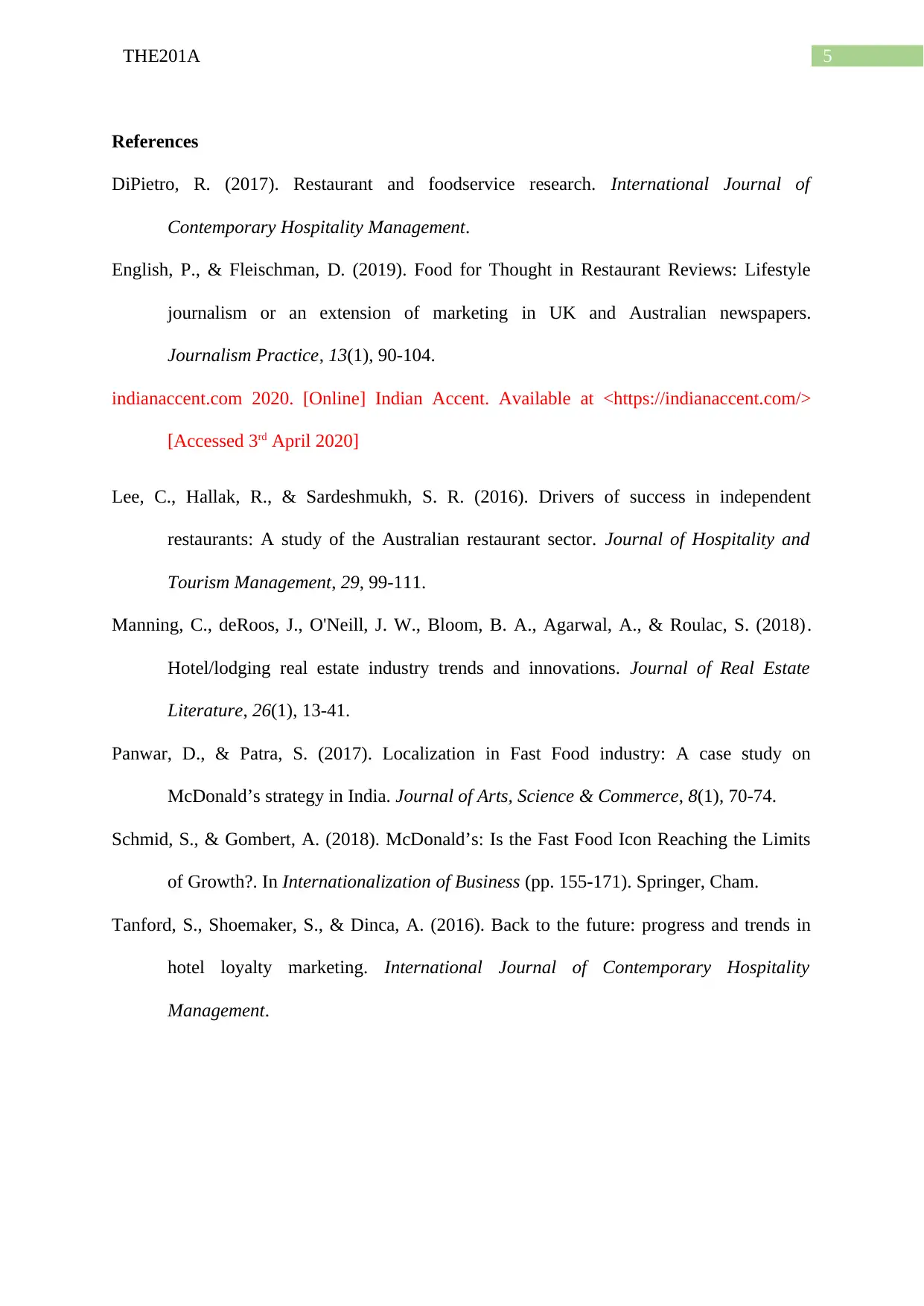
5THE201A
References
DiPietro, R. (2017). Restaurant and foodservice research. International Journal of
Contemporary Hospitality Management.
English, P., & Fleischman, D. (2019). Food for Thought in Restaurant Reviews: Lifestyle
journalism or an extension of marketing in UK and Australian newspapers.
Journalism Practice, 13(1), 90-104.
indianaccent.com 2020. [Online] Indian Accent. Available at <https://indianaccent.com/>
[Accessed 3rd April 2020]
Lee, C., Hallak, R., & Sardeshmukh, S. R. (2016). Drivers of success in independent
restaurants: A study of the Australian restaurant sector. Journal of Hospitality and
Tourism Management, 29, 99-111.
Manning, C., deRoos, J., O'Neill, J. W., Bloom, B. A., Agarwal, A., & Roulac, S. (2018).
Hotel/lodging real estate industry trends and innovations. Journal of Real Estate
Literature, 26(1), 13-41.
Panwar, D., & Patra, S. (2017). Localization in Fast Food industry: A case study on
McDonald’s strategy in India. Journal of Arts, Science & Commerce, 8(1), 70-74.
Schmid, S., & Gombert, A. (2018). McDonald’s: Is the Fast Food Icon Reaching the Limits
of Growth?. In Internationalization of Business (pp. 155-171). Springer, Cham.
Tanford, S., Shoemaker, S., & Dinca, A. (2016). Back to the future: progress and trends in
hotel loyalty marketing. International Journal of Contemporary Hospitality
Management.
References
DiPietro, R. (2017). Restaurant and foodservice research. International Journal of
Contemporary Hospitality Management.
English, P., & Fleischman, D. (2019). Food for Thought in Restaurant Reviews: Lifestyle
journalism or an extension of marketing in UK and Australian newspapers.
Journalism Practice, 13(1), 90-104.
indianaccent.com 2020. [Online] Indian Accent. Available at <https://indianaccent.com/>
[Accessed 3rd April 2020]
Lee, C., Hallak, R., & Sardeshmukh, S. R. (2016). Drivers of success in independent
restaurants: A study of the Australian restaurant sector. Journal of Hospitality and
Tourism Management, 29, 99-111.
Manning, C., deRoos, J., O'Neill, J. W., Bloom, B. A., Agarwal, A., & Roulac, S. (2018).
Hotel/lodging real estate industry trends and innovations. Journal of Real Estate
Literature, 26(1), 13-41.
Panwar, D., & Patra, S. (2017). Localization in Fast Food industry: A case study on
McDonald’s strategy in India. Journal of Arts, Science & Commerce, 8(1), 70-74.
Schmid, S., & Gombert, A. (2018). McDonald’s: Is the Fast Food Icon Reaching the Limits
of Growth?. In Internationalization of Business (pp. 155-171). Springer, Cham.
Tanford, S., Shoemaker, S., & Dinca, A. (2016). Back to the future: progress and trends in
hotel loyalty marketing. International Journal of Contemporary Hospitality
Management.
⊘ This is a preview!⊘
Do you want full access?
Subscribe today to unlock all pages.

Trusted by 1+ million students worldwide
1 out of 6
Related Documents
Your All-in-One AI-Powered Toolkit for Academic Success.
+13062052269
info@desklib.com
Available 24*7 on WhatsApp / Email
![[object Object]](/_next/static/media/star-bottom.7253800d.svg)
Unlock your academic potential
Copyright © 2020–2025 A2Z Services. All Rights Reserved. Developed and managed by ZUCOL.





